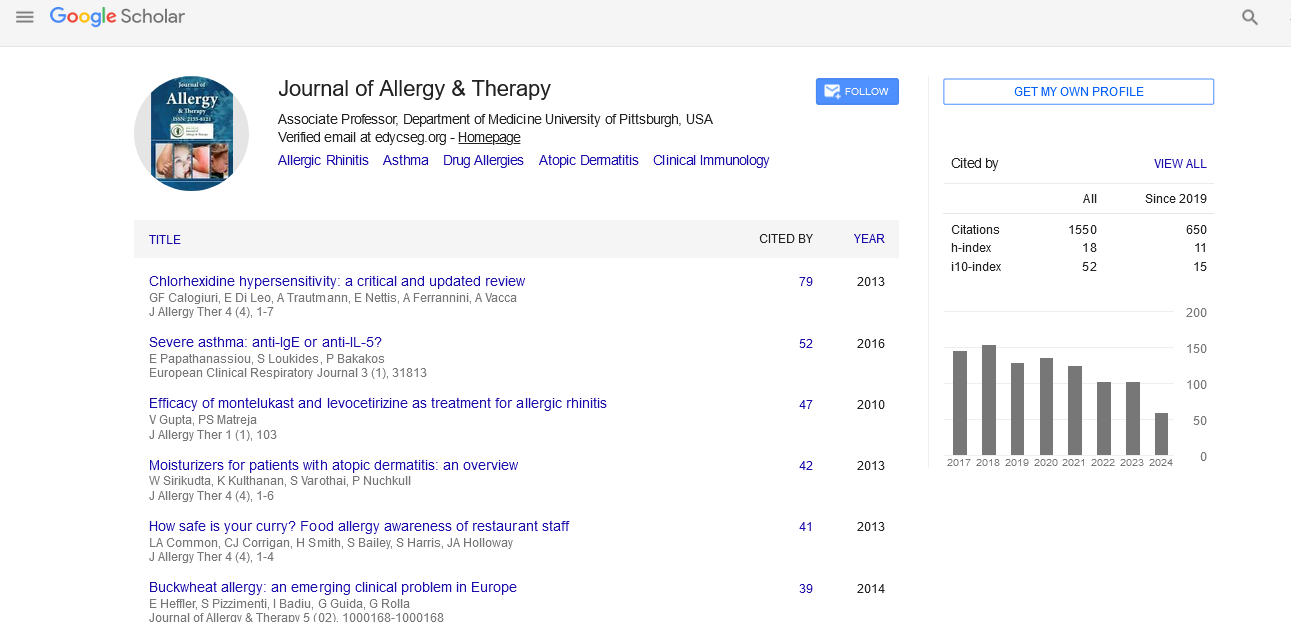Indexed In
- Academic Journals Database
- Open J Gate
- Genamics JournalSeek
- Academic Keys
- JournalTOCs
- China National Knowledge Infrastructure (CNKI)
- Ulrich's Periodicals Directory
- Electronic Journals Library
- RefSeek
- Hamdard University
- EBSCO A-Z
- OCLC- WorldCat
- SWB online catalog
- Virtual Library of Biology (vifabio)
- Publons
- Geneva Foundation for Medical Education and Research
- Euro Pub
- Google Scholar
Useful Links
Share This Page
Journal Flyer

Open Access Journals
- Agri and Aquaculture
- Biochemistry
- Bioinformatics & Systems Biology
- Business & Management
- Chemistry
- Clinical Sciences
- Engineering
- Food & Nutrition
- General Science
- Genetics & Molecular Biology
- Immunology & Microbiology
- Medical Sciences
- Neuroscience & Psychology
- Nursing & Health Care
- Pharmaceutical Sciences
Perspective - (2025) Volume 16, Issue 1
Emerging Biomarkers in Allergy Diagnosis and Treatment Monitoring
Kari Nadeau*Received: 31-Jan-2025, Manuscript No. JAT-25-27996; Editor assigned: 03-Feb-2025, Pre QC No. JAT-25-27996; Reviewed: 17-Feb-2025, QC No. JAT-25-27996; Revised: 24-Feb-2025, Manuscript No. JAT-25-27996; Published: 03-Mar-2025, DOI: 10.35248/2155-6121.25.16.411
Description
The identification and validation of novel biomarkers has become increasingly important in the field of allergology, offering potential improvements in diagnosis accuracy, treatment selection and monitoring of therapeutic responses. Traditional allergy diagnostics, including skin prick tests and specific Immunoglobulin E (IgE) measurements, while valuable, provide limited information about disease severity and treatment prognosis. The emergence of new biomarkers has opened possibilities for more precise patient stratification and personalized treatment approaches, aligning with the growing emphasis on precision medicine in allergology. Recent research has identified several promising biomarker categories, including molecular components, cellular markers, and genetic signatures. Specific IgE component testing has evolved to include comprehensive molecular diagnostics, enabling better risk assessment and more targeted intervention strategies.
The role of Basophil Activation Testing (BAT) has expanded, offering insights into both diagnosis and treatment monitoring. These cellular assays provide functional information about the allergic response that complements traditional testing methods. The development of multiplex platforms has revolutionized biomarker analysis, allowing simultaneous measurement of multiple markers from small sample volumes. This technology has particular relevance in pediatric populations where sample volume is often limited. Integration of biomarker data with clinical parameters has led to the identification of distinct endotypes within traditional phenotypes, supporting more targeted therapeutic approaches. Cytokine profiling has emerged as a valuable tool in understanding disease mechanisms and monitoring treatment responses. Specific patterns of cytokine expression have been associated with different allergic phenotypes and can predict response to biological therapies. The measurement of epithelial-derived cytokines, including Interleukin (IL)-25, IL-33 and TSLP, provides insights into disease pathogenesis and potential therapeutic targets.
MicroRNA profiles have shown promise as both diagnostic and prognostic markers in allergic diseases. These small non-coding RNAs plays crucial role in immune regulation and have demonstrated utility in distinguishing between different allergic conditions and monitoring treatment responses. Advances in detection technologies have made microRNA analysis more accessible for clinical applications. Metabolomic approaches have revealed distinctive patterns associated with allergic diseases, offering new perspectives on disease mechanisms and potential therapeutic targets. The analysis of exhaled breath condensate, particularly in asthma, has identified novel markers of airway inflammation and oxidative stress. These non-invasive approaches hold particular promise for monitoring disease activity and treatment response.
Proteomic analysis has identified novel protein signatures associated with allergic diseases, providing insights into underlying mechanisms and potential therapeutic targets. The integration of proteomic data with other biomarker measurements has enhanced our understanding of disease heterogeneity and treatment response variations. Machine learning approaches have proven valuable in analyzing complex biomarker datasets and identifying clinically relevant patterns. The development of point-of-care testing platforms has made some biomarker measurements more accessible in clinical settings. These rapid testing approaches can facilitate more timely treatment decisions and better monitoring of disease activity.
Conclusion
However, standardization of testing methods and interpretation criteria remains a significant challenge in biomarker implementation. Looking ahead, several areas require further investigation, including the validation of biomarker panels in large patient populations, development of standardized measurement protocols and integration of biomarker testing into clinical decision-making algorithms. The cost-effectiveness of biomarker testing must also be evaluated to support widespread implementation in clinical practice. The future of allergy diagnostics likely lies in integrated approaches combining multiple biomarker measurements with clinical parameters and patient-reported outcomes. This comprehensive assessment approach promises to enhance diagnostic accuracy and treatment optimization while supporting the development of more personalized therapeutic strategies.
Citation: Nadeau K (2025) Emerging Biomarkers in Allergy Diagnosis and Treatment Monitoring. J Allergy Ther. 16:411.
Copyright: © 2025 Nadeau K. This is an open-access article distributed under the terms of the Creative Commons Attribution License, which permits unrestricted use, distribution, and reproduction in any medium, provided the original author and source are credited.


